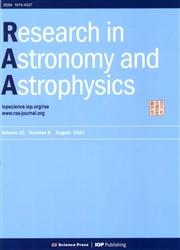Design and cryogenic performance of a hexapod platform for large ground-based wide field survey telescope
IF 2.8
4区 物理与天体物理
Q3 ASTRONOMY & ASTROPHYSICS
引用次数: 0
Abstract
Abstract Thermal gradient is an important factor causing degradation in the image quality of telescopes. In order to ensure the accurate alignment of the primary focus unit and the primary mirror, the hexapod platform (as a corrector) is investigated in this paper. First, a ground-based telescope with 2.5 m aperture and 3.5 deg field of view is described. The telescope is under construction, and it is expected to be finished in 2023. Secondly, the hexapod platform with flexure hinges utilized to adjust the primary focus unit is proposed, which is applied as a corrector. Then, the inverse kinematics of the platform is established and an open-loop control system is built based on it. Finally, the cryogenic performance test for the hexapod platform is performed. The experimental results show that the resolution and repeatability of the translation for the hexapod platform can be achieved at the micro-meter level. The resolution and repeatability of the rotation can be achieved at the arc-second level. Therefore, the cryogenic performance of the hexapod platform can meet the optical imaging requirements of the wide-field ground-based telescope. The kinematic analysis and cryogenic performance tests in the paper provide a technical reference for the precise alignment of the primary focus unit and the primary mirror, which can improve the imaging quality of the telescope.大型陆基广域观测望远镜六足平台设计及低温性能研究
热梯度是导致望远镜成像质量下降的重要因素。为了保证主聚焦单元与主反射镜的精确对准,本文对六足平台(作为校正器)进行了研究。首先,介绍了一种口径为2.5 m、视场为3.5°的地基望远镜。该望远镜正在建设中,预计将于2023年完工。其次,提出了利用柔性铰链调节主焦单元的六足平台作为校正器;然后,建立了平台的运动学逆解,并在此基础上建立了开环控制系统。最后,对六足平台进行了低温性能测试。实验结果表明,六足平台的平移分辨率和重复性可以达到微米级。旋转的分辨率和可重复性可达到弧秒级。因此,六足平台的低温性能可以满足地面大视场望远镜的光学成像要求。本文的运动学分析和低温性能试验为主聚焦单元与主反射镜的精确对准提供了技术参考,从而提高了望远镜的成像质量。
本文章由计算机程序翻译,如有差异,请以英文原文为准。
求助全文
约1分钟内获得全文
求助全文
来源期刊

Research in Astronomy and Astrophysics
地学天文-天文与天体物理
CiteScore
3.20
自引率
16.70%
发文量
2599
审稿时长
6.0 months
期刊介绍:
Research in Astronomy and Astrophysics (RAA) is an international journal publishing original research papers and reviews across all branches of astronomy and astrophysics, with a particular interest in the following topics:
-large-scale structure of universe formation and evolution of galaxies-
high-energy and cataclysmic processes in astrophysics-
formation and evolution of stars-
astrogeodynamics-
solar magnetic activity and heliogeospace environments-
dynamics of celestial bodies in the solar system and artificial bodies-
space observation and exploration-
new astronomical techniques and methods
 求助内容:
求助内容: 应助结果提醒方式:
应助结果提醒方式:


